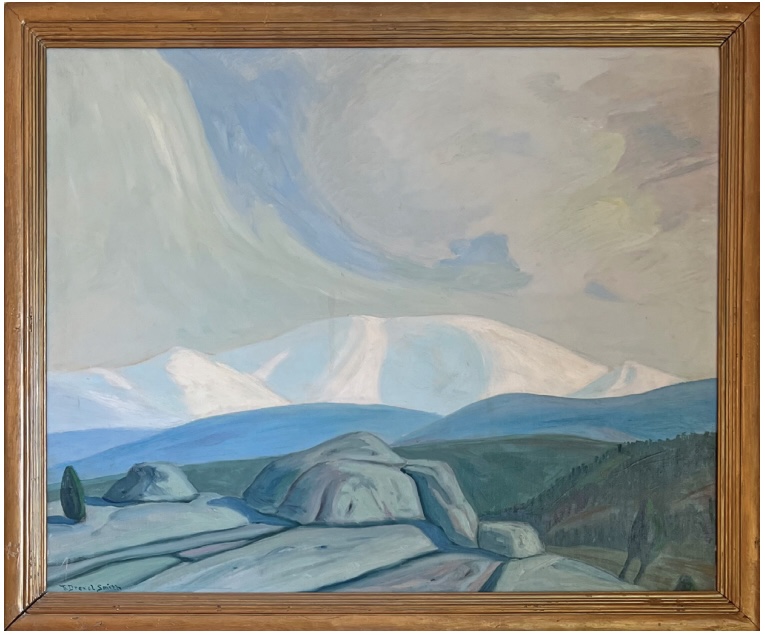Francis Drexel Smith (1874-1956) was an atypical artist in the Colorado Springs art community. He wasn’t a professional artist, he didn’t rely upon the sale of his paintings to bolster his finances and he was shy and retiring — not one to promote himself. And (bias alert!) he was my grandfather.
Born to a wealthy family in Chicago, Frank (as his friends knew him) grew up there and was accepted to the Chicago Art Institute after graduating from high school. He then worked at the family business, the Bradner-Smith Paper Co., then the largest such company in the United States.
In 1900, he married the strikingly beautiful Charlotte Silsbee; he then quit work and they moved to Colorado Springs in 1901. The young couple apparently loved the city and appreciated the genteel society that flourished at the foot of Pikes Peak.
By 1906, as Smith’s biographer Charles Farnsworth noted, “Frank and Charlotte had clearly made the social A-List, dining out with Chester Alan Arthur, the son of a former president, as well with two visiting members of the British nobility.”
His is an art without frills. – Peppino Mangravite
But their leisured and predictable lifestyle was soon disrupted. Charlotte had a secret lover, Bob Walsh, a Wyoming rancher/banker/polo player. The two had decided to leave Colorado Springs together on the 5 p.m. train to Sheridan in June 1911.
Frank was with friends at the El Paso Club when he heard the news, and ran desperately down the street to the Denver & Rio Grande Railroad Depot to stop them. The train was just pulling out of the station, and Frank ran alongside for hundreds of yards before giving up and almost collapsing.
The newspapers had a field day reporting the scandal. The stories noted that Smith, in tears, had been taken back to the club by his friends, who had revived him with invigorating spirits.
Charlotte and Frank divorced, and he suddenly became the city’s most eligible bachelor. In 1914, he married Edith Farnsworth, a sprightly, athletic widow and built a beautiful home at 531 N. Cascade Ave.
In 1919, Frank helped found the Broadmoor Art Academy (which would eventually become the Colorado Springs Fine Arts Center), studied under John F. Carlson and Robert Reid, and became a serious artist. He was also a founding member of the Fine Arts Center and kept a studio there for 25 years.
From 1921 to 1945, he created about 200 substantial paintings, won multiple awards and developed a unique style of western regionalism. Charles Farnsworth wrote that, “Frank’s stark, spare Colorado scenes often suggest a loneliness, an unpopulated emptiness … but his bright colors ward off any sense of doom or gloom.”

Most depict mountains, neighborhoods and buildings in Colorado Springs and the Pikes Peak region. He had a particular affection for Cripple Creek, Victor and the Westside. He transformed aimless industrial landscapes into subtle and beautiful paintings that reward viewers. At first, they seem quickly dismissable — but they linger in your mind.
Take “Old House on the Prairie,” a Depression-era rendition of a roofless and abandoned house on the Colorado plains. It’s silent and self-contained, without comment or context. You wonder who lived there, how they lived and where they went.
“The painting of Francis Drexel Smith is essentially American. His is an art without frills and without dogmas,” fellow artist Peppino Mangravite once said.
But Smith also liked to trip the light fantastic. One painting titled “Unicorn in Field at Dawn” shows a white unicorn facing down two crouching demons. Another, originally titled “Slaves of the Dog,” has been retitled “Buddhas and the Dog.” It shows a dog trotting past multiple figures seated with crossed legs.
Smith’s Cripple Creek paintings are among his best. “Winter in Cripple Creek” is arguably his masterpiece. It’s in the Fine Arts Center’s collection, but it needs restoration and hasn’t been displayed for many years.
Another Cripple Creek scene, “Dawn at Anna Marcovna’s,” depicts a Cripple Creek brothel around 1900, as does a companion piece, “The Gay Nineties.”
His work was most recently exhibited in 2019, in a retrospective at the Pioneers Museum. The museum owns many of his paintings, as does the CSFAC. Others belong to his descendants, but many more are in unknown hands.
Check your walls, attics and basements — they’re always signed “F. Drexel Smith.” And yeah, they’re worth something …

